Assessing the effect of environmental and socio-economic factors on skin melanoma incidence: an island-wide spatial study in Gran Canaria (Spain), 2007-2018
- PMID: 35925499
- PMCID: PMC9427872
- DOI: 10.1007/s10552-022-01614-6
Assessing the effect of environmental and socio-economic factors on skin melanoma incidence: an island-wide spatial study in Gran Canaria (Spain), 2007-2018
Abstract
Introduction: Skin melanoma incidence has risen in the last decades becoming a major public health problem in many regions of the world. Geographic variation of rates is not well understood.
Purpose: To assess the spatial distribution of skin melanoma in Gran Canaria Island (Canary Islands, Spain) and to evaluate the role of environmental, socio-economic, and demographic factors in this distribution.
Methods: We performed a small-area study with disease mapping at the census-tract level (CT) in Gran Canaria between 2007 and 2018. After testing for spatial autocorrelation, we integrated individual-level health data with census-based demographic and socio-economic indicators, and satellite-based environmental data. Finally, we assessed the role of demographic, socio-economic and environmental factors on skin melanoma incidence using a Bayesian analytical framework, with options for non-spatial and spatial random effects.
Results: 1058 patients were diagnosed with invasive skin melanoma in the study period and geolocated to a CT (number of CT in Gran Canaria = 565). We found evidence of global spatial autocorrelation in skin melanoma incidence (Moran's I = 0.09, pseudo p-value = 0.001). A few hotspots were detected, fundamentally in urban northern tracts. A radial pattern of high values was also observed in selected ravines with historical isolation. Multivariable conditional autoregressive models identified urbanicity, percent of females, and a high socio-economic status as risk factors for disease. Solar radiation did not show a significant role.
Conclusion: Urbanicity and a high socio-economic status were identified as the main risk factors for skin melanoma. These associations might reflect differential melanoma susceptibilities or be explained by health inequalities in detection. This study also uncovered high-risk areas in particular ravines. Future targeted research in these regions might help better understand the role of genetic and toxic factors in melanoma pathogenesis.
Keywords: Environment; Epidemiology; Melanoma; Socio-economic factors; Spain; Spatial analysis.
© 2022. The Author(s).
Conflict of interest statement
The authors have no conflicts of interest to declare that are relevant to the content of this article.
Figures



Similar articles
-
The incidence of skin melanoma in Gran Canaria (Canary Islands, Spain) is lower than expected in Southern Europe despite high-risk environmental conditions: an island-wide cross-sectional study.Cancer Causes Control. 2021 May;32(5):525-535. doi: 10.1007/s10552-021-01403-7. Epub 2021 Mar 1. Cancer Causes Control. 2021. PMID: 33646461
-
Opioid prescription patterns in the province of Las Palmas, Canary Islands, Spain (2016-2020): differences between urban and rural areas.Front Pharmacol. 2023 Jul 18;14:1184457. doi: 10.3389/fphar.2023.1184457. eCollection 2023. Front Pharmacol. 2023. PMID: 37533632 Free PMC article.
-
Groundwater intensive exploitation and mining in Gran Canaria and Tenerife, Canary Islands, Spain: Hydrogeological, environmental, economic and social aspects.Sci Total Environ. 2016 Jul 1;557-558:425-37. doi: 10.1016/j.scitotenv.2016.03.038. Epub 2016 Mar 24. Sci Total Environ. 2016. PMID: 27017075
-
Wave energy to power a desalination plant in the north of Gran Canaria Island: Wave resource, socioeconomic and environmental assessment.J Environ Manage. 2019 Feb 1;231:546-551. doi: 10.1016/j.jenvman.2018.10.071. Epub 2018 Oct 26. J Environ Manage. 2019. PMID: 30388651 Review.
-
[Melanoma epidemiology in Spain].Actas Dermosifiliogr. 2005 Sep;96(7):411-8. doi: 10.1016/s0001-7310(05)73105-7. Actas Dermosifiliogr. 2005. PMID: 16476268 Review. Spanish.
Cited by
-
Targeted screening and single-cell analysis of genetic variants in melanoma using Mendelian randomization.Discov Oncol. 2025 Jul 19;16(1):1376. doi: 10.1007/s12672-025-03225-4. Discov Oncol. 2025. PMID: 40682633 Free PMC article.
-
Spain's Rising Melanoma Threat: A Comprehensive 30-Year Analysis (1990-2019).Cancers (Basel). 2024 Mar 15;16(6):1167. doi: 10.3390/cancers16061167. Cancers (Basel). 2024. PMID: 38539502 Free PMC article.
References
-
- The Global Cancer Observatory—International Agency for Research on Cancer Melanoma of Skin—Globocan (2020) https://gco.iarc.fr/today/data/factsheets/cancers/16-Melanoma-of-skin-fa.... Accessed 23 Sept 2021
MeSH terms
LinkOut - more resources
Full Text Sources
Medical

